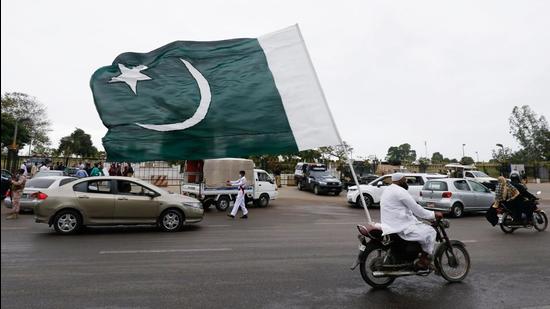The implications of the two-nation theory
Fifty years since the creation of Bangladesh, Pakistan’s ideology — based solely on Islam — remains rigid. This is why its bilateral engagement with India has failed
Pakistan’s foundational principle is the two-nation theory. It asserts that the Muslims of the Indian subcontinent constitute a nation, and Islam is antithetical to Hinduism. The creation of Bangladesh established that religion cannot be the principal — leave alone the only — ingredient of nationalism. Yet, 50 years after it lost its eastern part, Pakistan continues to stubbornly adhere to the two-nation theory in all its implications.

The army is committed to the nazaria-e-Pakistan whose main constituent is the two-nation theory. The political class dares not cross the army. Voices calling for ideological nationalism to be replaced by its territorial version are lost in the wilderness. More importantly, for the country’s polity and society, the forces of Islamism are getting ever stronger. They may have deep theological differences among themselves, but they reinforce the two-nation theory by stressing the more rigid versions of faith.
The shock of the 1971 disaster did not lead Pakistan to transform itself into a progressive country and consolidate democracy. Just the opposite. It turned more vigorously to conservative Islam; in 1974, then prime minister Zulfiqar Ali Bhutto constitutionally made the Ahmadis non-Muslims.
President Zia ul-Haq entrenched Islam more robustly in the polity, society and the army. All his successors, whether civil or military, have only walked the Islamist path. It is no wonder that Pakistan has reached a pass when the slightest rumour of blasphemy brings out mobs crying for blood. The brutal lynching of the Sri Lankan engineer in Sialkot on December 3 is not an aberration, but the bitter fruit of Pakistan’s choice to adhere to its moorings.
The Pakistani establishment has applied the two-nation theory to its relations with India. As India’s majority is Hindu and as, according to Jinnah — the creator of Pakistan — the Muslim “outlook is not only fundamentally different but also opposed to Hindus”, it became inevitable for Pakistan to be confrontational towards India and consider it a permanent enemy. Official Pakistani literature makes this obvious as is vividly indicated in the Abbottabad Commission Report. (The Commission was appointed to go into matters relating to the United States (US) action against Osama bin Laden in May 2011). Pakistan has unceasingly pursued hostile policies over the past 50 years. Indeed, the events of 1971 have instilled a relentless desire in the army and religious groups to settle scores and shun the path of reconciliation and cooperation.
There have been three important elements in Pakistan’s approaches towards India since its dismemberment in 1971.
One, in conformity with its policy before that year, it has relied on foreign powers to balance India. This has included China, but the US as well, especially in the 1980s. At that time, the US needed Pakistan in the Afghanistan context and looked the other way as it developed nuclear weapons.
Two, with China’s assistance, it developed nuclear weapons. In addition to the role of these weapons in the country’s defence against existential threats, Pakistan has used them as a shield for covert and bloody aggression.
Three, while its use of informal forces against India goes back to 1947, Pakistan has, since 1989, continuously and in a calibrated manner, pursued terrorism through its terrorist proxies. It has intended to keep India on the defensive, especially in Jammu and Kashmir (J&K).
Relying on these three factors which flow from the two-nation theory, Pakistan has never been serious about normalising ties and building a cooperative relationship. In focusing on confrontation, and not walking the path of cooperation, Pakistan has paid a heavy economic price, but it has willingly incurred it. In this, it has departed from the early decades when it did business with India. After that, it gradually shut the doors to trade and business, showing an invigoration of animosity which is in keeping with growing orthodox Islamism. Currently, Pakistan hopes that the Chinese connection, especially through the China-Pakistan Economic Corridor (CPEC) will lift its economy, but that is unlikely.
All through the past half-century, Pakistan has emphasised that India’s so-called intransigence on J&K is the cause of negative bilateral ties. Its official position has been the application of the United Nations resolutions, but its actual desire has been the amalgamation of the Muslim majority areas of the two Union Territories into Pakistan. It is believed that Bhutto had indicated to then Prime Minister Indira Gandhi at Shimla in 1972 that the only solution was the formalisation of the territorial status quo.
He did not take any serious steps to put that into practice. Since 1971, the only real bilateral engagement on J&K was through the Manmohan Singh-General Pervez Musharraf backchannel, but that did not finally yield results. It is doubtful if even an army chief — then and more so, now — would be allowed to make real or perceived concessions on J&K. Through his Kargil action, Musharraf also destroyed any prospect of an easing of India-Pakistan tensions.
Afghanistan has witnessed differing India-Pakistan positions during the over four decades of turmoil and tragedy. Notwithstanding its denials, Pakistan has sought strategic depth through it to trouble India. During the period of the Afghan republic, it was unrealistically worried about India causing problems on its western border. With the Taliban’s return, it is more relaxed. But will the Taliban shun India? Moreover, it is doubtful if India is willing to play the game.
Will Pakistan’s ideology ever allow it to seek constructive ties with India? If the history of the past 50 years is an indicator, then no.
Vivek Katju is a former diplomat
The views expressed are personal
All Access.
One Subscription.
Get 360° coverage—from daily headlines
to 100 year archives.



HT App & Website







